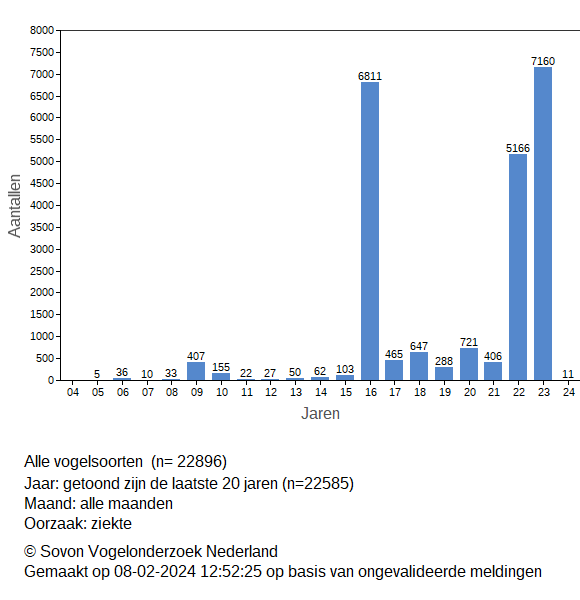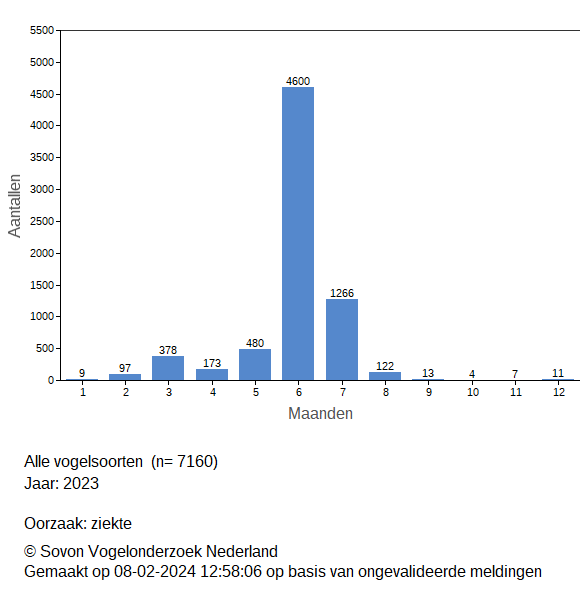

Since the last major outbreak of bird flu in 2023, mainly among gulls and terns, the spread of bird flu among wild birds in the Netherlands has been relatively little. However, the virus is still around. It is important to stay vigilant on sick and dead birds.
In recent years there have been outbreaks of bird flu regularly among wild birds in the Netherlands. In 2016, for example, there has been a major outbreak among mainly Eurasian Wigeons and Tufted Ducks. In June of 2022 many Sandwich Terns fell victim, while in the spring of 2023 thousands of Black-headed gulls were affected. Since then it was been relatively quiet, although we still receive reports of sick or dead birds. There are also still reports of infection on poultry farms, with the last outbreak taking place on 1 December 2023 in Putten.
The bird flu infections of the past two yeas have been caused by the highly pathogenic virus type H5N1. Several variants of this virus type have currently been found in both wild and captive birds, it is not yet known whether these new variants are less infectious for birds than previous variants, or whether there are other explanations for the fact that there now appears to be less virus circulating and that there have been relatively few outbreaks this past winter.


The virus has been present in wild bird populations for months now and is still causing mortality, although fortunately less than last summer, Some birds have developed partial protection against the disease, which means they die less quickly, bur are also sick for longer. This means that diagnosing the virus has become more complicated.
Testing birds for the bird flu virus is usually done by taking samples from the trachea and cloaca. A bird only excretes virus (on average) for the first seven days of infection. If a bird is sick or longer before it dies, the tests may be negative, even though the bird has bird flu. It is therefore possible that birds that show symptoms of bird flu, such as holding their head crooked, walking in circles, being unable to fly, etc., test negative. Other diseases can also cause these symptoms. The DWHC is working with other research institutions in the Netherlands on better testing methods for diagnosing bird flu in dead wild birds.
In other countries in Europe, there are now also fewer outbreaks than in the autumn of 2023, but outbreaks are still occurring. Outbreaks occasionally occur in Germany, France, Denmark, Hungary, Belgium, Poland, Bulgaria, Sweden, and the United Kingdom, among others. It is difficult to predict what will happen in the coming months. The virus can mutate again and it is also possible that migratory birds will bring other variants to the Netherlands in the spring. The virus has not gone away and is expected to continue to occur in the Netherlands in the coming months.
The online bird flu radar shows that the chance of the introduction of bird flu in our region remains high (see figure below). This predication is based on a statistical model that uses data on the numbers, distribution, and migratory movements of birds in Europe (for more information, see: https://www.sovon.nl/risico-op-vogelgriep-voorspellen-van-week-tot-week ).

As long as bird flu is still circulating in the Netherlands, it remains important to report dead or sick birds quickly. This van be done via https://dwhc.nl/en/report/ or https://portal.sovon.nl/dood
On the page Latest Information bird flu test results, you will find the most recent overview of bird flu test results per bird species in 2024 and overviews from previous years.